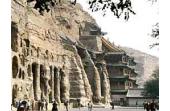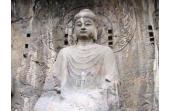Yungang Grottoes
- Things to do
-
- Photo(9)
- Tips&article(19)
- Make it Happen
- Map
-
loading...
Summary
Enrolled as a World Heritage Site by the UNESCO in 2001, Yungang Grottoes represent the excellent achievement of Buddhist sculptural art of ancient China, and it is the largest among the four most famous ancient grotto complexes in China.
Introduction
Yungang Grottoes with 252 caves and 51,000 Buddhist statues are the classical masterpieces of of Chinese Buddhist art in the 5th and 6th centuries. They were first carved out of the sandstone cliffs on Wuzhou Mountain in 453 AD, during the Northern Wei Dynasty (386-533). The main construction spanned for about forty years, and it was roughly completed in 525. Mia's Travel Story with Photos
The whole grotto complex is magnificent with delicate carvings. All the statues are precious and vivid, representing the development of art, architecture, music and religion at that time. Yungang Grottoes extend about 1 kilometer (0.6 miles) long from east to west, and are divided into east, middle and west parts.
Caves in the east part are mainly built in with pagodas. Caves in the middle part usually have front and back rooms, with the main Buddhist statue in the center, while the walls and the ceilings are carved with sculptures. Caves in the west part are medium and small caves and niches.
Caves No 5 and 6 in the middle part of the Yungang Grottoes are the most impressive. Inside the 5th cave is a 17-meter tall Buddhist statue, which is the largest one of Yungang Grottoes. Inside the 6th cave, besides large Buddhist statues, there are precious sculptures telling the story of Sakyamuni.
The sculptures inside the caves are all magnificent and multi-colored with excellent workmanship. At the other extreme, the 14-meter-high seated Buddha of Sakyamuni outside Grotto No. 20 commands respect not only for its size, but also for the face of the figure, which is characterized by soft lines and a pair of eyes that radiate intellectual and spiritual vigor.

China Highlights at the Yungang Grottoes


Yungang Grottoes stretches 1 kilometer long.


Vivid frescos and sculptures inside the cave.

History
At the time of the interior adornment of the Magao and Yungang Grottoes, Buddhism was in ascendance in China. The unique beauty of the Yungang Grottoes was recognized almost immediately upon their completion. The most culturally significant figures in the Yungang Grottoes, after the Buddha figures, is perhaps the statues of the five Chinese emperors. These important works of art are among the few historical relics to survive the Northern Wei Dynasty.
The emergence of the art of the Yungang Grottoes (and the same applies even more emphatically to the Magao Grottoes) is intimately linked to the Silk Road that connected China to the outside world from the 1st century BC to the 16th century AD. The Silk Road was of course primarily a trade route, but it was also a communications route in the broadest sense, i.e., ideas traversed from east to west and vice-versa. One such idea that travelled from east to west during the era of the Silk Road was Buddhism. Indeed, the Magao Grottoes lie directly on the original, northern Silk Road route.
In 2001, UNESCO officially recognized the cultural importance of the Yungang Grottoes by including them on UNESCO's World Cultural Heritage List.
Travel Essentials
- Ticket fare: 130 yuan per person (including 70 yuan as admission fee and 60 yuan for Caves No 5 and 6)
- Location: It is about 16 kilometers southwest of Datong city center, taking no more than 30 minutes by car.
- Opening time:
Summer (April 15-October 31): 8:30-17:00
Winter (November 1-April 14): 8:30-16:30 - Recommended visiting time: 2 hours
- Getting there:
Take public bus No. 3-1, 3-2, 10 or 12 (Ticket fare:1 yuan per person)
Take a taxi from city center to Yungang Grottoes costs about 40 yuan.
Related Links
- One-Day Datong Classic Tour including Nine Dragon Screen, Yungang Grottoes and Huayan Temple
- Datong Tour Packages
- World Heritage Sites in China
- Introduction of China’s History
- Mogao Grottoes in Dunhuang City, Gansu Province
Tips & articles
|
|
|
forum discussion
|
|
|












